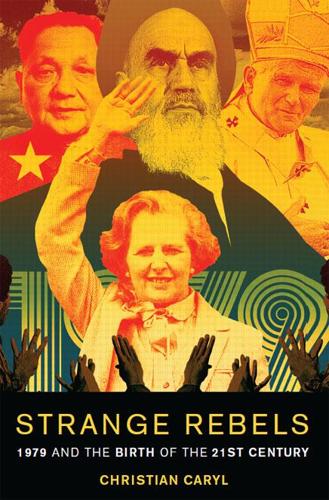
Strange Rebels: 1979 and the Birth of the 21st Century
by
Christian Caryl
Published 30 Oct 2012
The villagers had vivid memories of what had happened to other families who had acted against state policy, so they also agreed that they would raise the children (until the age of eighteen) of any village leaders who were arrested or shot as a result of the agreement. The Xiaogang villagers had no way of knowing that farmers all around China were trying to get away with similar plans. But Anhui Province was a bit different. The food situation there was so dire that some officials were willing to turn a blind eye to what the farmers were doing17—even while others persisted with obstruction, denying fertilizers to the experimenters.18 The new party chief in Anhui, another victim of the Cultural Revolution, had his own ideas. Wan Li had assumed the leadership of the province in 1977, just before Deng’s comeback, and he soon realized that the comeback of household contracting was the only way to make sure that people avoided starvation.
…
As we now know, however, not every place in the Chinese countryside was in the grip of the same stagnation witnessed by Mosher. There were a few communities where both farmers and officials were quietly testing the limits of the possible. One of the most intriguing was the village of Xiaogang, in a part of Anhui Province that had been hit especially hard by Great Leap starvation. Fengyang County had lost ninety thousand people—a quarter of its population—between 1958 and 1960.13 In the 1950s, Xiaogang village had thirty-four households; by 1979, migration and starvation had reduced the number to eighteen.14 In bad years, due to drought or mismanagement from above, the villagers had to sell possessions for food or borrow money for seed.
…
Mosher, 37–38. 12. Ibid., 40. 13. “Xiaogang Village, Birthplace of Rural Reform, Moves On,” Wang Ke, China.org. cn, December 15, 2008, http://www.china.org.cn/china/features/content_16955209.htm. 14. How the Farmers Changed China: Power of the People, by Kate Xiao Zhou, 56. 15. “Xiaogang Village, Birthplace of Rural Reform, Moves On,” Ke. 16. Ibid. 17. “Farmers Who Provided the Spark,” Raymond Li, South China Morning Post, November 17, 2008. 18. How the Farmers Changed China, Zhou, 53–54. 19. “Xiaogang Village, Birthplace of Rural Reform, Moves On,” Ke. 20. How the Farmers Changed China, Zhou, 53–54. 21. http://mengwah.wordpress.com/2011/03/31/3–1-reforming-the-agricultural-sec-tor-contract-responsibility-system/. 22.
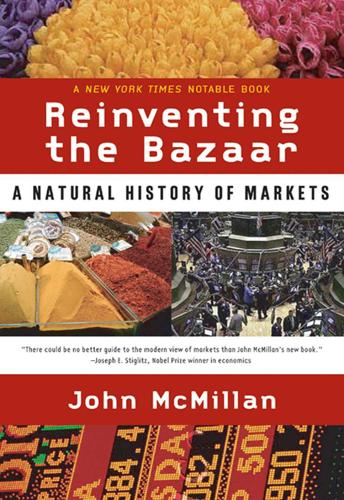
Reinventing the Bazaar: A Natural History of Markets
by
John McMillan
Published 1 Jan 2002
Food production boomed with the farmers’ new individual incentives. The marketization of agriculture lifted hundreds of millions of Chinese out of dire poverty. It was the biggest antipoverty program the world has ever seen. A tiny beginning sparked this massive reform: a clandestine meeting of the householders in a small rural village. Desperation had hit the farmers of Xiaogang village in China’s Anhui province by 1978. The commune on which they worked collectively was dysfunctional. Known as the granary of China, Anhui contains some of the nation’s most fertile land. But Xiaogang’s twenty families were not producing enough rice to feed themselves.
…
Word got out, despite their oath of secrecy. No one understood the inefficiencies of communal farming better than the farmers themselves. All over China, farmers were ready to change. With wildcat breakups of communes in other villages, the movement quickly proliferated. Individual farming spread “like a chicken pest,” as a farmer put it. “When one village has it, the whole county will be infected.”5 The grassroots reforms were initially resisted from the top. Foreseeing a loss of their power and perquisites, the local bureaucrats punished Xiaogang by cutting off its supplies of seeds, fertilizer, and pesticides. But the villagers were lucky: their uprising coincided with a change of mood in Beijing.
…
The state deliberately set the price of rice artificially low. The old Eastern European lament applied also in China: “We pretend to work, they pretend to pay us.” The upshot was that the farmers in the communes had little incentive to exert effort. It made little difference whether a farmer worked himself to exhaustion or dozed all day under a tree. Either way, the amount he took home to feed his family was much the same. “The enthusiasm of the farmers was frustrated,” said Yan Junchang, a Xiaogang village leader. “No matter how hard I rang the bell or blew the whistle, I couldn’t get anyone to go into the fields.” The missing incentives translated into low output.
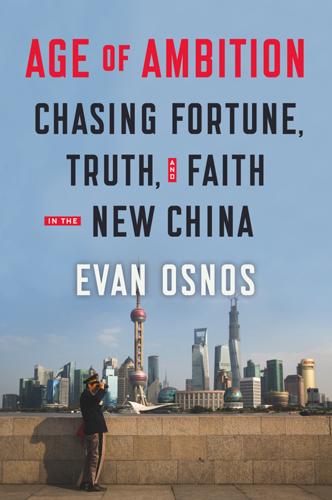
Age of Ambition: Chasing Fortune, Truth, and Faith in the New China
by
Evan Osnos
Published 12 May 2014
On matters of the economy, his shrewdest move was to unite with Chen Yun, a fellow Party patriarch who was so skeptical of the West that he greeted the idea of reform by rereading Lenin’s Imperialism; and with Zhao Ziyang, a younger, progressive Party boss whose efforts to reduce poverty had spawned a saying among peasants: “If you want to eat, look for Ziyang.” When change came, it came from below. The previous winter, in the inland village of Xiaogang, the local farmers had been so impoverished by Mao’s economic vision that they had stopped tilling their communal land and had resorted to begging. In desperation, eighteen farmers divided up the land and began to farm it separately; they set their own schedules, and whatever they sold beyond the quota required by the state, they sold at the market and reaped the profits. They signed a secret pact to protect one another’s families in the event of arrest.
…
For much of the nineties, authorities arrested performance artists for appearing in the nude, shut down experimental shows, and bulldozed underground artists’ villages. But the influx of money transformed the relationship between artists and the government. By 2006, Chinese painters such as Zhang Xiaogang were selling pieces for close to a million dollars, and a younger generation of artists, raised in the boom years, let it be known that they were tired of addressing authoritarianism and politics. Like artists elsewhere, they trained their sights on consumerism, culture, and sex, and they encountered a new generation of speculators and collectors.
…
This describes the fact that the most successful film ever made about two of China’s national symbols, kung fu and pandas, had to be made by a foreign studio (DreamWorks), because no Chinese filmmaker would ever have been allowed to have fun with such solemn subjects. The censors at the State Administration of Radio, Film, and Television had always worked in secrecy; they never publicized their orders, but now directors were taking their complaints to the public. In April 2013 the filmmaker Feng Xiaogang was giving a mundane acceptance speech for the Director of the Year award when he seized the chance to make a bold statement; he cut short his list of thank-yous and said, “For the last twenty years, every director in China has faced a kind of tremendous torment, and that torment is censorship.” Feng was no dissident; he’d made a bare-handed fortune on romantic comedies and big-budget epics, but the decades of compromises and concessions were rubbing a raw spot on his professional pride.

Progress: Ten Reasons to Look Forward to the Future
by
Johan Norberg
Published 31 Aug 2016
Even after this disaster, food was scarce in China because the collective farms stifled work and innovation. No one could make more by working harder or investing in better methods. Today, China’s leaders are proud of its productive agricultural sector, but it did not change because of a top-down decision. It was started by a few brave peasants in the Xiaogang village in Anhui province in December 1978. The eighteen families of the village were desperate. The communist system did not supply them or their children with enough to eat. Some families had to boil poplar leaves and eat them with salt; others ground roasted tree bark to use as flour. So they met in secret late one night and agreed to parcel out the communal land among themselves.
…
The villagers agreed that if word got out and any of them were jailed or executed, the others would raise their children. The farmer who had drawn up the contract hid it inside a piece of bamboo in the roof of his house, and hoped that the officials would never find it. In the end, word of this secret privatization got out. The result was just too good to keep a secret. The farmers did not start the workday when the village whistle blew any longer – they went out much earlier and worked much harder. There was a dramatic surge in production. Grain output in 1979 was six times higher than the year before. Other villages could see that Xiaogang did better, and that people there were better fed, and tried to find out what they had done differently.
…
At the start of the 1980s the city of Guangzhou, in the south-east Chinese province of Guangdong, had two buildings of more than ten floors. This was one of the poorer provinces of a desperately poor China, with neither capital nor resources for development. But farmers and villagers had started small businesses and began to improve production. As we saw in the case of the farmers in Xiaogang, they often did so without official recognition, but it inspired the leadership to think differently. In its efforts to raise the country out of its abysmal poverty, the Chinese communist party learned from the Asian ‘tiger’ economies of South Korea, Taiwan, Hong Kong and Singapore, but also from local experiments with private farming and township enterprises.
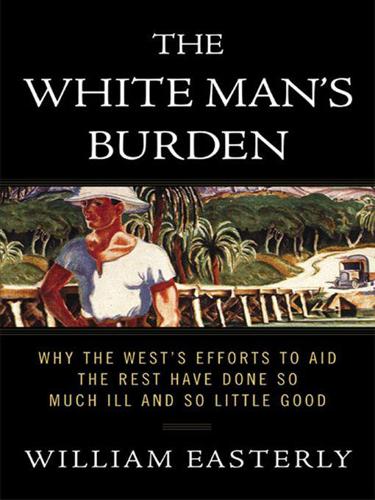
The White Man's Burden: Why the West's Efforts to Aid the Rest Have Done So Much Ill and So Little Good
by
William Easterly
Published 1 Mar 2006
These examples of dynamism at the bottom have not yet propelled the societies as a whole into sustained growth, for all the reasons given in this chapter and the next. Individuals are dynamic, yet the complex interactions of individuals in society can cause stagnant economies. Still, the dynamism of the poor at the bottom can sometimes lead to emergence out of stagnation of the wider society. Miracle in Xiaogang In the tiny village of Xiaogang, Anhui province—the heart of China’s rice-growing region—twenty families held a secret meeting in 1978. The villagers were desperate because they were starving. As Stanford economist John McMillan tells the story, the commune system that the Communists had in place all over China was leading to a breakdown in food production.
…
Under this system, everybody was collectively responsible for tilling the land, and everybody had a share in the land’s output. You got your rice share whether you worked hard or not, and as a result people hardly worked. The villagers of Xiaogang reached an agreement: they would divide up the land and farm it individually, with each person keeping the output of his own land. They kept their agreement a secret out of fear of the Communist authorities. Rice production in Xiaogang shot up. The results were too spectacular to stay secret for long. Neighboring villages wanted to know how Xiaogang had increased its rice production so much. Other villages also put into place individual farming. Before long, the Communist authorities got wind of the spontaneous outbreak of property rights in the countryside.
…
Less anecdotally, China now accounts for 63 percent of American imports of women’s shoes.22 Not that China just exports shoes. I do a quick survey of my apartment. My New York Yankees baseball cap—made in China. My clock radio—made in China. My USB FlashDrive for my computer—made in China. The laptop computer itself—made in China. The exploration of free markets that started with the end of agriculture communes in Xiaogang in 1978, as told in a previous chapter, spread to industrial as well as agricultural enterprises. On December 24, 2004, the New York Times did a story on China’s textile enclaves. Datang is China’s Socks City, producing nine billion pairs of socks a year, a third of the world’s output. As recently as the late 1970s, Datang was a sleepy rice-growing village of less than a thousand people.

Open: The Story of Human Progress
by
Johan Norberg
Published 14 Sep 2020
This is a fairy tale, as economists like Weiying Zhang and Nina Wang have documented, and to the extent that the party believes its own myth it will be detrimental to the future of China.51 The changes that began to dismantle the Maoist command economy did not emerge from the heads of planners but from the initiative of starving villagers. Peasants in Xiaogang in Anhui province started to privatize their land in secret in December 1978, which increased production dramatically, and inspired others to do the same. Private farming spread ‘like a chicken pest’, as one farmer put it. ‘When one village has it, the whole country will be infected.’52 Soon other villagers started small companies operating outside the plan, and developed a pricing system, while unemployed young Chinese began to demand the right to open small shops and businesses.
…
(Huntington), 110 Wildavsky, Aaron, 321 Wilde, Oscar, 278 Wilkins, John, 157 William III and II, King of England, Scotland and Ireland, 101, 186, 193 William of Rubruck, 96 Wilson, Edward Osborne, 234 wind power, 328 windmills, 171 Windows, 305–6, 310 witches, 215, 356 Witold Rybczynski, 288 Wolff, Christian, 153 Wollstonecraft, Mary, 27 wolves, 26 women’s rights, 27–8, 99, 205 Wordsworth, William, 297 World Bank, 3 World of Yesterday, The (Zweig), 214 World Trade Organization (WTO), 19, 63 World Values Survey, 112, 114, 339 World War I (1914–18), 54, 104, 214 World War II (1939–45), 56, 64, 109, 124–6, 220, 340, 343 Worthless, Impossible, and Stupid (Isenberg), 296 Wozniak, Stephen, 304 Wrangham, Richard, 226, 227, 229 Wright, Robert, 249–50, 251 Xenophanes of Colophon, 130, 131 Xenophon, 132 Xiaogang, Anhui, 315 Yamen, Guangdong, 173 Yamnaya people, 75 Yangtze river, 172 Yangzhou, Jiangsu, 174, 352 Yankees, 58 Yellow river, 172 Yemen, 75, 111, 365, 366 YouTube, 310 Yuan Empire (1271–1368), 174–5 Zachary, Gregg Pascal, 83 Zaire (1971–97), 187 Zakaria, Fareed, 358 Zephaniah, 46 zero-sum thinking, 9, 14, 185, 214, 248–85, 333, 348, 367–70 equality matching, 262–6, 267 folk economics, 258–62 grouping and, 252–5 inequality and, 273 physical fallacy, 267–8 racism and, 358–9 religion and, 248–52 Schumpeterian profits, 273–5 social status, 281–5 trade and, 270–72 Zhang Weiying, 315 Zheng He, 177–8 ziggurats, 39 Zimbabwe, 56 Zolberg, Aristide, 112 Zweig, Stefan, 214
…
INDEX Abbasid Caliphate (750–1258), 6, 136–7, 138, 169, 353 abortion, 113 absolutist monarchies, 154, 155, 170, 182, 185 Academy Awards, 82 Accenture, 375 accountants, 41 Acemoglu, Daron, 185, 187, 200 Achaemenid Empire (550–330 BC), 86–7, 88, 249 Acton, Lord, see Dalberg-Acton, John Adams, Douglas, 295 Adobe, 310 Advanced Research Projects Agency (ARPA), 306 Aeschylus, 132 affirmative action, 244 Afghanistan, 70, 345 Age of Discovery, 177 agriculture, 39–40, 42, 74, 171, 263 Akbar I, Mughal Emperor, 98 Akkadian Empire (c. 2334–2154 BC), 42 Alaska, 76 Albania, 54 Albertus Magnus, Saint, 145 d’Alembert, Jean-Baptiste le Rond, 154 Alexander III ‘the Great’, Basileus of Macedon, 87–9 Alexandria, Egypt, 134 algae, 332 algebra, 137 Alibaba, 311 Allport, Gordon, 244–5 Almohad Caliphate (1121–1269), 137–8 alpha males, 227–8, 229 Alphaville, 245 altruism, 216 Amalric, Arnaud, 94 Amazon, 275, 311 America First, 19, 272 American Civil War (1861–5), 109 American Declaration of Independence (1776), 103, 201, 202 American Revolutionary War (1775–83), 102–3, 200–201 American Society of Human Genetics, 76–7 Americanization, 19 Amherst, William, 1st Earl Amherst, 176–7 amphorae, 48 Amsterdam, Holland, 150, 152, 153 An Lushan Rebellion (755–63), 352 anaesthesia, 279, 296 anagrams, 83 Anatolia, 42, 74 Anaximander, 127 Anaximenes, 127 al-Andalus (711–1492), 97, 137–9, 140 Andromeda, 88 Anglo–French Treaty (1860), 53–4 Anhui, China, 315 anti-Semitism, 11, 94–7, 109, 220, 233, 251, 254, 255 anti-Semitism, 254–5, 356 Antonine Plague (165–80), 77 Antoninus Pius, Roman Emperor, 91 Apama, 88 Appiah, Kwame Anthony, 5 Apple, 82, 195, 304, 311, 319 Apuleius, 89 Arab Spring (2011), 10, 342 Arabic numerals, 70, 137, 156 Arabic, 136, 137, 140 archaeology, 21–2, 31, 32, 38, 43, 50, 51 Archer Daniels Midland, 329 Aristides, Aelius, 48 Aristophanes, 129, 131, 132 Aristotle, 130–31, 132, 137, 141–6, 161 Armenians, 136, 220 ARPAnet, 306 Art Nouveau, 198 art, 198 Artaxerxes III, Persian Emperor, 87 Ashkenazi Jews, 99 Ashoka, Mauryan Emperor, 53 Assyria (2500–609 BC), 248–9 Assyrian Empire (2500–609 BC), 41, 43, 86 astronomy, 80, 145–6, 150 Atari, 304 Athens, 47, 53, 89, 90, 131, 134 Atlas Copco, 65 Augustine of Hippo, 133, 139 Australia, 50–53, 76, 262 Australopithecus afarensis, 24–5 Austria, 1, 150, 151, 190 Austria-Hungary (1867–1918), 179, 254 Battle of Vienna (1683), 237, 238 Habsburg monarchy (1282–1918), 151, 179, 190, 237 migration crisis (2015–), 342 Mongol invasion (1241), 95 Nazi period (1938–45), 105 Ötzi, 1–2, 8–9, 73, 74 Thirty Years War (1618–48), 150 Authoritarian Dynamic, The (Stenner), 343 authoritarianism, 4, 14, 220, 343–61, 363, 379 democracy and, 357 economics and, 346–51 exposure to difference and, 242 innovation and, 318 insecurity and, 338, 342, 378 media and, 346–9 nostalgia and 351–4 predisposition, 220, 343–6 populism and, 325, 350–51 scapegoats and, 355–6 science and, 161–3 automatic looms, 179 automation, 63, 312–13 Averroes, 137–8, 143, 144, 145 Aztec Empire (1428–1521), 55 Bab-el-Mandeb Strait, 75 baby-boom generation (1946–64), 294, 340 Babylon, 39, 86–7 Babylonia (1895–539 BC), 39, 42, 43, 86–7, 128, 131, 249, 267 Bacon, Francis, 147, 156, 165–6, 201 bad news, 322 Baghdad, 70, 136, 353 Bahrain, 42 Bailey, Ron, 11 Bailyn, Bernard, 201 balance of trade, 59–60 Banda Islands, 100 Bangladesh, 270 Bannon, Steve, 14, 108 Barcelona, Catalonia, 320 Basel, Switzerland, 152 Battle of Vienna (1683), 237, 238 Bayezid II, Ottoman Sultan, 98 Bayle, Pierre, 158 Beginning of Infinity, The (Deutsch), 332 Behavioural Immune System, 222 Beirut, Lebanon, 236 benefit–cost ratio, 60, 61, 62 Berges, Aida, 80 Bering land bridge, 76 Berkeley, see University of California, Berkeley Berlin Wall, fall of (1989), 10, 340, 341, 363, 364 Berners-Lee, Timothy, 307–8 Bernstein, William, 42 Berossus, 267 Better Angels of Our Nature, The (Pinker), 243 Beveridge, William, 59 Béziers, France, 94 Bezos, Jeffrey, 274, 275–6, 277 Bi Sheng, 171 Bible, 46, 72, 248–50, 296 bicycles, 297 de Biencourt, Charles, 189 Big Five personality traits, 7 Black Death (1346–53), 77, 139, 208, 356, 352, 356 Blade Runner, 334 Bletchley Park, Buckinghamshire, 124–6 Blue Ghosts, 236 Bohr, Niels, 105 Bolt, Beranek and Newman (BBN), 307 bonobos, 226–7 Book of Jonah, 248–50 Borjas, George, 116 Boston, Massachusetts, 122, 223 Boudreaux, Donald, 62, 270 Boulton, Matthew, 194 Bowles, Samuel, 216 Boym, Svetlana, 288 Brandt, Willy, 364 Brewer, Marilynn, 247 Brexit (2016–), 9, 14, 118, 238, 240–41, 349, 354, 379 Brezhnev, Leonid, 315 Britain, 169, 181–99 Acts of Union (1707), 101, 194 Afghanistan War (2001–14), 345 Amherst Mission (1816), 176–7 anti-Semitism in, 254 arts, 198 Bletchley Park, 124–6 Brexit (2016–), 9, 14, 118, 238, 240–41, 349, 354, 379 Cheddar Man, 74 Cobden–Chevalier Treaty (1860), 53–4 coffee houses, 166 colonies, 84, 191, 194, 200 Corn Laws repeal (1846), 53, 191 creative destruction in, 179 crime in, 119, 120 Dutch War (1672–4), 101 English Civil War (1642–1651), 148, 183, 184, 201 Glorious Revolution (1688), 101, 185–8, 190, 193 hair powder tax (1795), 72 immigration in, 113, 115, 118, 119, 120, 193–4 Industrial Revolution, 188–99, 202 innovation in, 53, 189–90 Internet, development of, 307–8 Iraq War (2003–11), 345 Levellers, 183–4, 186 literacy in, 188, 198 literature, 188–9 London Bridge stabbings (2019), 120 London 7/7 bombings (2005), 341 Macartney Mission (1793), 176 Magna Carta (1215), 5 monopolies, 182 MPs’ expenses scandal (2009), 345 Muslim community, 113 Navigation Acts, 192 nostalgia in, 294 open society, 169, 181–2, 195–9 patent system, 189–90, 203, 314 Peasants’ Revolt (1381), 208 political tribalism in, 238, 240–41 poverty in, 256 railways in, 297 Royal Society, 156, 157, 158, 196, 296 ruin follies, 286–7 slavery, abolition of (1807), 182, 205 smuggling in, 192 Statute of Labourers (1351), 208 United States, migration to, 104 West Africa Squadron, 205 Whig Party, 185, 201 World War II (1939–45), 124–6 British Broadcasting Corporation (BBC), 135 Bronze Age (c. 3300–600 BC) Late Bronze-Age Collapse (1200–1150 BC), 44, 49, 54 migration to Europe, 74–5 Phoenician civilization, 43–6, 49, 70 Sumerian civilization, 42–3 Brotherton, Rob, 322 Brown, Donald, 219, 283 Bruges, Flanders, 208 Bruno, Giordano, 150 Bryn Mawr College, 201 Buddhism, 96, 149, 352 Bulgaria, 73, 342 Bureau of Labor Statistics, US, 65 Burke, Edmund, 152, 292 Bush, George Walker, 328 ByteDance, 318 Byzantine Empire (395–1453), 94, 134, 135, 155, 224 California Gold Rush (1848–1855), 104 Calvin, John, 149 Calvinism, 6, 99, 153, 356 Canada, 235, 258 Caplan, Bryan, 258 Caracalla, Roman Emperor, 91 Carbon Engineering, 332 Cardwell, Donald, 10 Cardwell’s Law, 10 Carlson, Tucker, 82, 302 Carlyle, Thomas, 206 Carthage (814–146 BC), 45 Caspian Sea, 75 Cathars, 94, 142 Catherine II, Empress of Russia, 154 Catholicism, 208 in Britain, 101, 185–6, 191 Crusades, 94, 138 in Dutch Republic, 99 exiles and, 153 in France, 154 Jews, persecution of, 97–8, 100, 106, 140, 233 Inquisition, 94, 97, 98, 100, 143, 150 in Italy, 6, 169 Muslims, persecution of, 97, 106, 233 Papacy, 102, 142, 143, 152, 155, 178, 237 in Rwanda, 230–31 in United States, 102, 104, 108, 254 values and, 114 Cato’s Letters (Trenchard and Gordon), 201 Celts, 89, 289 Central Intelligence Agency (CIA), 313 Ceres, 89 Cerf, Vinton, 307 CERN (Conseil européen pour la recherche nucléaire), 306, 307 chariot racing, 224 Charles I, King of England, Scotland and Ireland, 148, 179, 183 Chávez, Hugo, 354 Chechen War, Second (1999–2009), 354 Cheddar Man, 74 cheongsam dresses, 73 Chesterton, Gilbert Keith, 286, 300 Chicago principles, 164–5 Chicago, Illinois, 202 child mortality, 168–9 Child, Josiah, 184 children, 26 chimpanzees, 24, 25, 32, 36, 226–7, 228 China, 4, 5, 6, 13, 84, 270, 314–18 Amherst Mission (1816), 176–7 An Lushan Rebellion (755–63), 352 Antonine Plague (165–80), 77 authoritarianism, 4, 162–3, 175, 318, 325, 343 budget deficits, 60 cheongsam dresses, 73 Confucianism, 129, 149, 169, 176 COVID-19 pandemic (2019–20), 4, 11–12, 162–3 Cultural Revolution (1966–76), 355 dictatorships, support for, 367 dynamism in, 315–18 ethnic groups in, 84 Great Wall, 178 industrialization 169, 172–3, 207 intellectual property in, 58 kimonos, 73 literacy in, 148 Macartney Mission (1793), 176 Ming dynasty (1368–1644), 54, 148, 175, 177–8, 179, 215 national stereotypes, 235, 236 overcapacity in, 317 paper, invention of, 136 private farming initiative (1978), 315–16 productivity in, 317 poverty in, 273, 316 Qing dynasty (1644–1912), 148, 149, 151, 153, 175–7, 179, 353 Reform and Opening-up (1979–), 4, 53, 56, 315–16 SARS outbreak (2002), 162 science in, 4, 13, 70, 153, 156, 162–3, 169–73, 269 Silk Road, 171, 174, 352 Song dynasty (960–1279), 53, 169–75 state capitalism in, 316–17 Tang dynasty (618–907), 84, 170, 177, 352 Taoism, 129, 149 trade barriers, 59 United States, migration to, 104, 109, 254 United States, trade with, 19, 57, 58–9, 62–3, 64 WTO accession (2001), 63 Yuan Empire (1271–1368), 174–5 Zheng He’s voyages (1405–33), 177–8 Chinese Exclusion Act (1882), 254 Christensen, Clayton, 305 Christianity, 46, 70, 96, 129 Bible, 46, 72, 248–50, 296 in Britain, 101 Calvinism, 6, 99, 149, 153, 356 Cathars, 94, 142 clash of civilizations narrative, 237 Crusades, 94, 138 Catholicism, see Catholicism Dominican order, 356 in Dutch Republic, 99 economic hardship and, 359 fundamentalism, 133–5, 149 Great Awakening (1730–55), 102 Great Vanishing, 134–5 Inquisition, 97, 98, 100 Jews, persecution of, 95, 96, 97 Lutheranism, 99, 356 in Mongol Empire, 96 Old Testament, 46, 72 orthodox backlash, 149–50 Orthodox Church, 155 Papacy, 102, 142, 143, 152, 155, 178, 233 Protestantism, 99, 104, 148, 149, 153, 169, 178 Puritanism, 99, 102 Rastafari and, 72 Reformation, 148, 155 in Roman Empire, 90, 93–4 science and, 133–5, 141–6, 149–50 Thirty Years War (1618–48), 97 tribalism and, 230–31, 246 zero-sum relationships and, 248–50 Chua, Amy, 84 Cicero, 141 Cilician, Gates, 42 cities, 40, 79, 140 division of labour in, 40 immigration and, 114, 250 innovation and, 40, 53, 79, 140, 145, 172, 287 liberalism and, 339 Mesopotamia, 37–43 open-mindedness and, 35 productivity and, 40, 98 tradition and, 287, 291 turtle theory and, 121–2 civic nationalism, 377–8 civil society, 6, 199, 253, 358, 363 clash of civilizations narrative, 237, 362–3, 365–6 ‘Clash of Civilizations?’
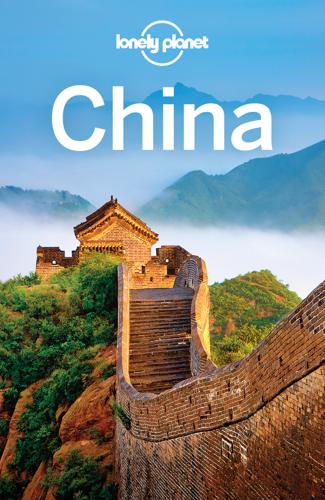
Lonely Planet China (Travel Guide)
by
Lonely Planet
and
Shawn Low
Published 1 Apr 2015
Ask to get off at Jiulong Bridge (jiulong qiao), which is a little closer to the palace. Buses from Mizhi to Yan’an (¥53.50, 3½ hours, three daily) depart at 7.40am, 8.20am and 1.30pm. Anhui Anhui Highlights Tunxi Around Tunxi Huizhou Villages Huangshan Jiuhua Shan Hefei Anhui Pop 64.1 million Why Go? Well-preserved villages and fantastical mountain scapes are the principal draw for visitors to Anhui. The main attraction of this southern Huizhou region is unquestionably Huangshan, a jumble of sheer granite cliffs wrapped in cottony clouds that inspired an entire school of ink painting during the 17th and 18th centuries.
…
Month by Month Itineraries Regions at a Glance On The Road Beijing Beijing Highlights History Climate Language Sights City Walk Sanltun & Chaoyang Beihi Park & Xicheng North Dashilar & Xicheng South Summer Palace & Hidian Activities Courses Sleeping Eating Drinking & Nightlife Entertainment Shopping Around Beijing The Great Wall Ming Tombs Chuandxia Marco Polo Bridge & Wnping Town The Great Wall Visiting the Wall Mutianyu Gubeikou Jiankou Zhuangdaokou Jinshanling Badaling Tianjin & Hebei Tianjin & Hebei Highlights Tianjin Tianjin Hebei Shijiazhuang Around Shijiazhuang Chengde Shanhaiguan Jimingyi Shandong Ji’nan Around Ji'nan Zhujiayu Tai'an & Tai Shan Qufu Qingdao Lao Shan Getting There & Away Yantai Shanghai Shanghi Highlights History Language Climate Sights Courses Tours Festivals & Events Sleeping Eating Drinking & Nightlife Entertainment Shopping Around Shanghai Zhujiajiao Jiangsu Jiangsu Highlights Nanjing Around Nanjing Suzhou Around Suzhou Tongli Luzhi Mudu Tianping Shan & Lingyan Shan Zhouzhuang Zhejiang Zhejiang Highlights Hangzhou Around Hangzhou Wuzhen Xin'anjiang Around Xin'anjiang Putuoshan Fujian Fujian Highlights Xiamen Gulang Yu Fujian Tulou Quanzhou Around Quanzhou Fuzhou Wuyi Shan Liaoning Liaoning Highlights Shenyang Dalian Around Dalian Dandong Xingcheng Jilin Jilin Highlights Changbai Shan Yanji Ji’an Beidahu Ski Resort Changchun Heilongjiang Heilongjiang Highlights Ha’erbin Mudanjiang Around Mudanjiang Wudalian Chi Russian Borderlands Shanxi Shanxi Highlights Datong Around Datong Wutai Shan Taiyuan Pingyao Around Pingyao Qikou Jincheng Around Jincheng Shaanxi (Shanxi) Shaanxi Highlights Xi’an Around Xi’an Hua Shan Hancheng Yan’an Yulin Mizhi Anhui Anhui Highlights Tunxi Around Tunxi Huizhou Villages Huangshan Jiuhua Shan Hefei Henan Henan Highlights Zhengzhou Nanjiecun Song Shan & Dengfeng Luoyang Around Luoyang Guoliangcun Kaifeng Zhuxian Zhen Hubei Hubei Highlights Wuhan Jingzhou Around Jingzhou Wudang Shan Shennongjia Yichang Jiangxi Jiangxi Highlights Nanchang Around Nanchang Jingdezhen Wuyuan Around Wuyuan Sanqing Mountain Longhu Mountain Hunan Hunan Highlights Changsha Shaoshan Heng Shan Zhangjiajie Fenghuang Hongjiang Old Town Hong Kong Hong Kong Highlights History Language Sights Walking Tour Activities Tours Festivals & Events Sleeping Eating Drinking Entertainment Shopping Macau Macau Highlights History Language Sights Activities Tours Festivals & Events Sleeping Eating Drinking Entertainment Shopping Guangdong Guangdong Highlights Guangzhou Around Guangzhou Foshan Kaiping Yangjiang Zhaoqing Around Zhaoqing Qingyuan Nanling National Forest Park Shenzhen Around Shenzhen Zhuhai Chaozhou Around Chaozhou Meizhou Dabu Hainan Hainan Highlights Haikou Around Haikou Central Highlands Wuzhishan City (Tongshi) Around Wuzhishan City The East Coast Bo’ao Shimei Bay & Sun & Moon Bay Sanya Gungxi Gungxi Highlights Guilin Around Guilin Longji Rice Terraces Sanjiang Yangshuo Around Yangshuo Huangyao Nanning Yangmei Beihai Weizhou Island Huashan Cliff Murals Pingxiang Detian Waterfall Tongling Grand Canyon Leye Guizhou Guizhou Highlights Central Guizhou Guiyang Qingyan Eastern Guizhou Kaili Around Kaili Zhenyuan Around Zhenyuan Western Guizhou Anshun Around Anshun Weining Northern Guizhou Chishui Around Chishui Yunnan Yunnan Highlights Central Yunnan Kunming Around Kunming Shilin Heijing Jianshui Around Jianshui Yuanyang Rice Terraces Xiaguan Weishan Weibao Shan Dali Around Dali Nuodeng Shaxi Northwest Yunnan Lijiang Around Lijiang Baisha Shuhe Old Town Yulong Xueshan Tiger Leaping Gorge Tiger Leaping Gorge to Baishuitai Lugu Hu Shangri-la (Zhongdian) Around Shangri-la Deqin Around Deqin Nu Jiang Valley Liuku Fugong Bingzhongluo Dulong Valley Baoshan Region Tengchong Around Tengchong Dehong Prefecture Ruili Around Ruili Xishuangbanna Region Jinghong Around Jinghong Sichuan Sichuan Highlights Central Sichuan Chengdu Around Chengdu Emei Shan Le Shan Southern Sichuan Zigong Yibin Bamboo Sea Western Sichuan Kangding Danba Sichuan–Tibet Highway (Northern Route) Sichuan–Tibet Highway (Southern Route) Northern Sichuan Songpan Jiuzhaigou National Park Langzhong Chongqing Chongqing Highlights Chongqing City Dazu Buddhist Caves Zhongshan Songji Cruising the Yangzi The Three Gorges The River The Effects of the Three Gorges Dam The Route Chongqing to Wanzhou Wanzhou to Yichang Boats Luxury Cruises Tourist Boats Passenger Ships Hydrofoil Tickets Chongqing Yichang Fengjie Wuhan Xinjiang Xinjiang Highlights Central Xinjiang Urumqi Tian Chi Turpan Around Turpan Hami (Kumul) Kuqa Around Kuqa Southwest Xinjiang – Kashgaria Kashgar Karakoram Highway Southern Silk Road Yengisar Yarkand Karghilik Hotan Cherchen Charklik Northern Xinjiang Bu’erjin Kanas Lake Nature Reserve Yining Sayram Lake Gansu Gansu Highlights Lanzhou & Southern Gansu Lanzhou Linxia Xiahe Around Xiahe Hezuo Langmusi Hexi Corridor Wuwei Zhangye Mati Si Jiayuguan & Around Dunhuang Around Dunhuang Eastern Gansu Tianshui Around Tianshui Pingliang Ningxia Ningxia Highlights Yinchuan Around Yinchuan Zhongwei Around Zhongwei Guyuan & Around Inner Mongolia Inner Mongolia Highlights Hohhot Around Hohhot Shangdu (Xanadu) Baotou Wudang Lamasery Genghis Khan Mausoleum Haila’er Around Haila’er Jinzhanghan Grasslands Enhe Shi Wei Manzhouli Qinghai Qinghai Highlights Xining Around Xining Tongren (Repkong) Guide Yushu (Jyekundo) Around Yushu Tibet Tibet Highlights Lhasa Around Lhasa Ganden Monastery Nam-tso Samye Monastery The Friendship Highway Yamdrok-Tso Gyantse Shigatse Sakya Rongphu Monastery & Everest Base Camp Tingri to Zhangmu Zhangmu Western Tibet Lhatse to Kailash Mt Kailash Lake Manasarovar Understand Understand China China Today History People of China Religion & Philosophy Chinese Cuisine Arts & Architecture China's Landscapes Martial Arts of China Survive Directory AZ Accommodation Activities Children Customs Regulations Discount Cards Electricity Embassies & Consulates Gay & Lesbian Travellers Insurance Internet Access Language Courses Legal Matters Money Passports Post Public Holidays Safe Travel Telephone Visas Volunteering Transport Getting There & Away Getting Around China by Train Health Insurance Vaccinations Medical Checklist Websites Further Reading Language Behind the Scenes Our Writers Welcome to China Whether it’s your first visit or your twentieth, China is so big, so diverse and so fast-changing, it’s always an adventure.
…
At the foot of these ranges are strewn the ancient villages of Huizhou; their distinctive whitewashed walls and black-tiled roofs stand out against a verdant backdrop of green hills and terraced tea gardens. Anhui’s lush mountains and slower pace of life are the perfect antidote to the brashness of China’s larger cities. When to Go AMar Pack a camera to catch the flowering yellow rapeseed around Shexian. AOct Autumn days are best for climbing Huangshan. ADec The snowcapped rooftops of Xidi’s Hui houses look a picture. Best Mountains AHuangshan AJiuhua Shan AQiyun Shan Best Villages AXidi AHongcun AChengkan Anhui Highlights 1 Catch the sunrise from the iconic Chinese mountain, Huangshan. 2 Explore the grottoes and dilapidated temples at Taoist Qiyun Mountain. 3 Soak up the Ming-dynasty vibe along Tunxi’s Old Street. 4 Join the Buddhist pilgrims at fog-shrouded Jiuhua Mountain. 5 Don’t miss the World Heritage village of Hongcun. 6 Eschew crowds and enjoy authentic village life at Chengkan. 7 Admire the palette of the colourful gateway to Shuguangyu Hall in Pingshan. 8 Seek out the Pig’s Heaven Inn in Xidi for a fantastic meal. 9 Get your camera out at Shexian’s astonishing Tangyue Decorative Archways.
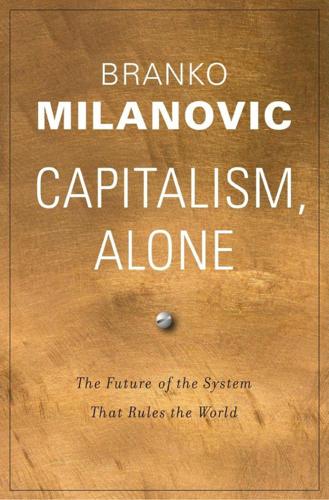
Capitalism, Alone: The Future of the System That Rules the World
by
Branko Milanovic
Published 23 Sep 2019
The beginning of the responsibility system, which would eventually cover all of China, goes back to twenty farm households in Fengyang Xiaogang village in Anhui Province who, like medieval conspirators, swore to stick by each other and secretly signed a document in which they agreed to divide the land into individual plots and deliver the required grain quotas to the government while keeping the rest for themselves. The possibility that such “capitalist-roaders” would be severely punished was not negligible. So the farmers vowed that “[they] will not regret [their decision] even if [they] have to face the death penalty. The rest of the members promise to take our kids until 18 years old” (Wu 2015, 32).
…
In the past, capitalism, whether in the Roman Empire, sixth-century Mesopotamia, medieval Italian city states, or the Low Countries in the modern era, always had to coexist—at times within the same political unit—with other ways of organizing production. These included hunting and gathering, slavery of various kinds, serfdom (with workers legally tied to the land and banned from offering their labor to others), and petty-commodity production carried out by independent craftspeople or small-scale farmers. Even as recently as one hundred years ago, when the first incarnation of globalized capitalism appeared, the world still included all of these modes of production. Following the Russian Revolution, capitalism shared the world with communism, which reigned in countries that contained about one-third of the human population.
…
The solution, according to House, would be to place China under international “trusteeship.”15 As the Chinese Civil War and the Great Depression further impoverished China, a survey of villages undertaken by the China Cotton Mill Owners’ Association for the purpose of estimating the demand for textiles “found disastrous conditions: women in Szechuan were not wearing skirts because the rural devastation had left farmers without the means to purchase cloth, and in many households family members shared one item of clothing” (Shiroyama 2008, 127). Vietnam at the same time was under the thumb of the French, who ran an efficient, extractive, and oppressive administration.16 The ideas of national liberation, territorial unification, and transformation of social relations were so remote and so weak that I do not think it is an exaggeration to say that not one bet in a million could rationally have been placed on their becoming a reality.
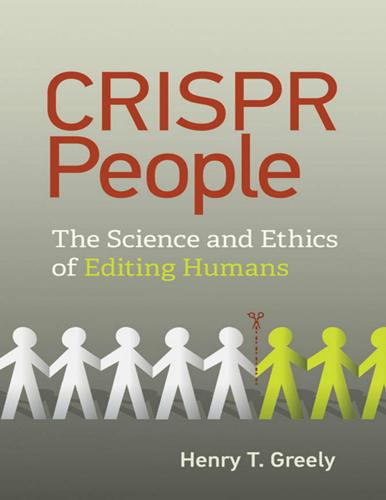
CRISPR People: The Science and Ethics of Editing Humans
by
Henry T. Greely
Published 22 Jan 2021
World Medical Association, “WMA Declaration of Helsinki—Ethical Principles for Medical Research Involving Human Subjects,” as amended October 2013, https://www.wma.net/policies-post/wma-declaration-of-helsinki-ethical-principles-formedical-research-involving-human-subjects. 5. 45 CFR § 46.111(a)(2). 6. 45 CFR § 46.111(a)(1). 7. Xiao-Hui Zhang, Louis Y. Tee, Xiao-Gang Wang, et al., “Off-Target Effects in CRISPR/Cas9Mediated Genome Engineering,” Molecular Therapy—Nucleic Acids 4, no. 11 (2015): e264, https://doi.org/10.1038/mtna.2015.37. 8. For a discussion of this possibility, see Xiao-Jiang Li, Zhuchi Tu, Weili Yang, et al., “CRISPR: Established Editor of Human Embryos,” Cell Stem Cell 21, no. 3 (2017): 295–296, https://doi.org/10.1016/j.stem.2017.08.007. 9.
…
He’s talent must have been recognized early; he was able to attend the best high school in the county: Xinhua No. 1 Middle School 284. Apparently He was obsessed by physics in high school. After being admitted to the University of Science and Technology of China, a highly regarded Chinese university in Hefei, Anhui Province (about 600 miles northeast of his home), he continued to study physics and graduated in physics in 2006. In 2007, sometime after his college graduation, He received a Chinese national scholarship to study in the United States, moving 7,500 miles this time to start in a Ph.D. program at Rice University in Houston, Texas.
…
But it gets even more complicated. Not only does the human germline genome change over time but humans indirectly “cause” those changes. Widespread adoption of agriculture changed the human germline genome. We have more starch digesting genes than our hunter-gatherer ancestors, not because some early farmer inserted them but because, given the diet available, babies who could digest starch better thrived and had more (better starch-digesting) children, and so on.18 Natural selection acts on humans, even when the “nature” has been modified by ourselves. When humans change the environment in ways relevant to themselves, and thereby change the fitness pressures that environment imposes, humans inevitably change which genetic variations get selected for and against.
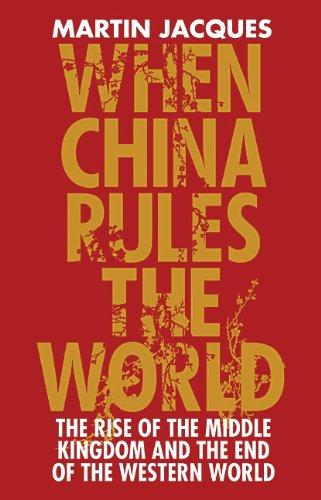
When China Rules the World: The End of the Western World and the Rise of the Middle Kingdom
by
Martin Jacques
Published 12 Nov 2009
In 2006 Sotheby’s and Christie’s, the world’s biggest auction houses, sold $190 million worth of contemporary Asian art, most of it Chinese, in a series of record-breaking auctions in New York, London and Hong Kong. At the end of that year a painting by contemporary artist Liu Xiaodong was sold to a Chinese entrepreneur for $2.7 million at a Beijing auction, the highest price ever paid for a piece by a Chinese artist. With auction sales of $23.6 million in 2006, Zhang Xiaogang was second only narrowly to Jean-Michel Basquiat in the ArtPrice ranking of the 100 top-selling artists in the world: altogether there were twenty-four Chinese artists in the list, up from barely any five years ago. These changes reflect the growing global influence of Chinese art and artists.90 China, however, still lags hugely behind the West when it comes to the international media.
…
Rogoff, Kenneth Rudd, Kevin rule of law rural migrant workers rural reform Russia samurai San Francisco Sarkozy, Nicolas Saudi Arabia science and technology scientific publications Senkaku/Diaoyu islands sense of guilt Shambaugh, David Shandong province Shanghai Shanghai Cooperation Organization (SCO) Shanghai Electric Shanghai Five Shenzhen Shi Yinhong Shimonoseki, Treaty of Shintaro, Ishihara ships Sichuan province Singapore Sino-Japanese War Sinocentrism see Middle Kingdom mentality skin colour Smith, Adam Song dynasty (AD 960-1279) South Asia South China Sea South-East Asia see also ASEAN South Korea farming population identity Mandarin learning Students in China urban population sovereign wealth funds Soviet Union special economic zones sports Spratly and Paracel islands state enterprises state sovereignty Steel, Valerie steppe nomads Su Xiaokang suffrage Sugihara, Kaoru suicide Sun Yat-sen Sun Zi superstitious customs surveillance system sustainability, of growth Taipei Taiping Uprising Taiwan China’s attitude to farming population modernity public opinion superstitious customs Taiwanese identity urban population Tang, David Tang dynasty (618-907) Tang Shiping Taoism Tata Nano tax reforms TCL tea culture technocratic class technology transfer Temasek Holdings tennis Terracotta Army territorial expansion terrorism Thailand Therborn, Göran Tianjin, Treaty of Tibet ‘time-compression societies’ Tokugawa era Tokyo (former Edo) tolerance tourism trade unions Treaty of Nanjing tributary system Tu Wei-ming Tung Chee-hwa UN peacekeeping operations, Chinese troops unequal treaties United Kingdom and China colonization decline of industrial employment Industrial Revolution Mandarin teaching overseas Chinese racism share of world population urban population United States and Africa and Australia and China colonized/colonies decline and East Asia economic strength and Europe foreign policies hegemony human rights debate importation of investment and India industrial employment insularity and the international system and Japan Mandarin teaching and Middle East overseas Chinese population rise of self perception understanding of universities United States Africa Command unity universalism universities urban population urbanization US dollar US National Intelligence Council report US Treasury bonds values Veriah, Harinder Vietnam Vietnamese (language) village election Wang Gungwu Wang Xiaodong war on terror waterway systems Wen Jiabao Wen Yudio the West concept of decline of and the developing world share of world population view on Asia modernity view on China Westernization food language physical appearance politics and power Westphalian system wet rice farming Wolferen, Karel van Wong Bin workplace World Bank world history writing system WTO Xinjiang Xu Zongheng Xuchang Man Yan Xuetong Yang Qingqing Yangzi Delta Yangzi river Yasukuni Shrine Yellow Emperor (Huang Di) yellow races Yoshino, Kosaku Yu Yongding Yuan dynasty (1279-1368) Yuan Shih-kai Yukichi, Fukuzawa Zambia Zhang Qingli Zhang Taiyan Zhang Wei-Wei Zhang Xiaogang Zhang Yimou Zhang Yin Zhang Yunling Zhang Zhidong Zhao Suisheng Zhao Ziyang Zheng He zhongguo Zhou dynasty (1100-256 BC) Zhou Enlai Zhu Feng Zhu Rongji Zi Zhongyun Zimbabwe
…
Since ingredients are not the same everywhere, Chinese food acquired an indigenous character simply by virtue of those used.84 Given the country’s size and population, there are, not surprisingly, huge regional variations in the character of Chinese food; indeed, it is more appropriate to speak of Chinese cuisines rather than a single tradition, with four schools often identified, namely Shandong, Sichuan, Jiangsu and Guangdong; and sometimes eight, with the addition of Hunan, Fujian, Anhui and Zhejiang; or even ten, with the further addition of Beijing and Shanghai.85 From very early on, Chinese cuisine incorporated foreign foodstuffs - for example, wheat, sheep and goat from Western Asia in the earliest times, Indonesian spices in the fifth century, and maize and sweet potato from North America from the early seventeenth century - all of which helped to shape the food tradition.86 The preparation of Chinese food involves, at its heart, a fundamental division between fan - grains and other starch foods - and ts’ai - vegetable and meat dishes.